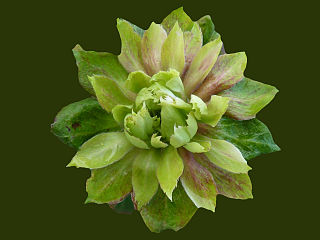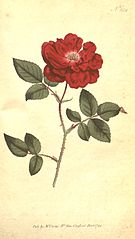| Rosa chinensis | |
|---|---|

| |
| A double-flowered cultivar | |
| Scientific classification | |
| Kingdom: | Plantae |
| Clade: | Tracheophytes |
| Clade: | Angiosperms |
| Clade: | Eudicots |
| Clade: | Rosids |
| Order: | Rosales |
| Family: | Rosaceae |
| Genus: | Rosa |
| Species: | R. chinensis |
| Binomial name | |
| Rosa chinensis Jacq. | |
| Synonyms | |
| |
Rosa chinensis (Chinese: 月季; pinyin: yuèjì), known commonly as the China rose, Chinese rose, or Bengal rose, is a member of the genus Rosa native to Southwest China in Guizhou, Hubei, and Sichuan Provinces. The first publication of Rosa chinensis was in 1768 by Nikolaus Joseph von Jacquin in Observationum Botanicarum, 3, p. 7 & plate 55.
Description
It is a shrub that reaches 1–2 m and grows in hedges or forms thickets. The leaves are pinnate, have 3–5 leaflets, each 2.5–6 cm long and 1–3 cm broad. In the wild species (sometimes listed as Rosa chinensis var. spontanea), the flowers have five pink to red petals. The fruit is a red hip one to two cm in diameter. The strong branches have a smooth purplish-brown bark, and there may be many to no curved, stocky, flat spines.
The alternately-arranged leaves, 12 to 27 cm long, are pinnately divided. The petiole and the rachis are sparsely spiny, with glandular hairs. The leaf blades usually have three or five or, rarely, seven leaflets, 2.5 to 6 centimeters in length, with a width of 1 to 3 centimeters, ovate or ovate-oblong with a weak-rounded or broad and wedge-shaped base, a more-or-less long, tapered apex and sharply toothed edge. The upper surface is shiny and dark green.
Inflorescence

In China, the flowering time of R. chinensis ranges from April to September. Rarely, the flowers are solitary; usually appearing in groups of four or five. The 2.5 to 6 cm long pedicel has variable hairiness. The one to three naked bracts are linear, with a pointed apex and a smooth or glandular margin. The flowers have a mild fragrance.
The hermaphrodite flowers have radial symmetry, with a diameter of four to five cm, and may be double. There are cultivated forms with simple to more or less strongly double flowers, which are also wild in China and nearby areas of temperate latitudes. The bald flower cup is egg-shaped, spherical or pear-shaped. The early-dropping sepals are ovate or sometimes leaf-like, simple or lobed, cupped towards the apex. The five to several or many petals are white-over-pink to red or purple, obovate with a wedge-shaped base and a rounded apex. There are many stamens. The free, hairy style is almost as long as the stamens. In China, the fruits ripen from June to November, turning red. They are egg-shaped to pear-shaped, with a diameter of one to two centimeters.
Cultivation
Various forms of Rosa chinensis have been cultivated in gardens in China for a long time; therefore, it is not easy to distinguish between wild forms and cultivated forms. Many varieties of garden roses have been bred from Rosa chinensis. The species is extensively cultivated as an ornamental plant, and numerous cultivars have been selected, which are known as the China roses. It has also been extensively interbred with Rosa gigantea to produce Rosa × odorata and by further hybridization the tea roses and hybrid tea roses, and is the source of summer-blooming varieties and those with continuous flowering.
Varieties
Three varieties of the species are recognized in the Flora of China:
- R. chinensis var. chinensis, originated in cultivation, with red petals
- R. chinensis var. spontanea, native to Guizhou, Hubei, and Sichuan, with red petals
- R. chinensis var. semperflorens (Curtis) Koehne, originated in cultivation, with dark red or purple petals
Uses
Cultivars developed from Rosa chinensis have been important in the breeding of many modern garden roses by providing the repeat-blooming characteristic, although this is not a feature of the wild species. The many forms of Rosa chinensis are also used in many other ways. The young vegetative plant parts, flower buds and flowers are brewed and eaten as a kitchen herb, for example, as a soup. From the rosehips, a thin fleshy layer that surrounds the seeds is eaten raw or cooked. The seed hair must be removed; It has to be handled very carefully. The seed hairs must not get into the mouth and throat. The seeds are a good source of vitamin E. The seeds can be ground and mixed with flour or added to other foods.
-
 18th-century painting of two cultivars
18th-century painting of two cultivars
-
A Rosa chinensis cultivar
-
 Rosa chinensis 'Viridiflora', in which the petals are replaced with leaves (phyllody)
Rosa chinensis 'Viridiflora', in which the petals are replaced with leaves (phyllody)
-
 Botanical illustration
Botanical illustration
-
 Rose 'Bengal Red'
Rose 'Bengal Red'
See also
References
- "The Plant List: A Working List of All Plant Species". Retrieved 28 December 2014.
- BSBI List 2007 (xls). Botanical Society of Britain and Ireland. Archived from the original (xls) on 2015-06-26. Retrieved 15 July 2015.
- NRCS. "Rosa chinensis". PLANTS Database. United States Department of Agriculture (USDA). Retrieved 15 July 2015.
- "Rosa chinensis". Germplasm Resources Information Network. Agricultural Research Service, United States Department of Agriculture. Retrieved 26 August 2021.
- Gu Cuizhi & Kenneth R. Robertson: Rosa : Rosa chinensis, p 368 - Registered text as printed work , In: Wu Zheng-yi & Peter H. Raven (Ed.): Flora of China , Volume 9 - Pittosporaceae through Connaraceae , Science Press and Missouri Botanical Garden Press, Beijing and St. Louis, 2003. ISBN 1-930723-14-8
- Heinrich Schultheis: Roses: the best types and varieties for the garden , p. 58, Ulmer: Stuttgart 1996, ISBN 3-8001-6601-1
- Ute Bauer: Old Roses: History, Use, Design, Nursing Practice , p. 14, BLV: Munich 2004, ISBN 3-405-16713-2
- Flora of China: Rosa chinensis
- Phillips, R.; Rix, M. (2004). The Ultimate Guide to Roses: A Comprehensive Selection. Macmillan. ISBN 1-4050-4920-0.
- Wu Zheng-yi & Peter H. Raven (ed.): Flora of China , Volume 9 - Pittosporaceae through Connaraceae , Science Press and Missouri Botanical Garden Press, Beijing and St. Louis, 2003. ISBN 1-930723-14-8 (Sections Description, Occurrence and Systematics)
 Media related to Rosa chinensis at Wikimedia Commons
Media related to Rosa chinensis at Wikimedia Commons- Plants for a Future: Rosa chinensis